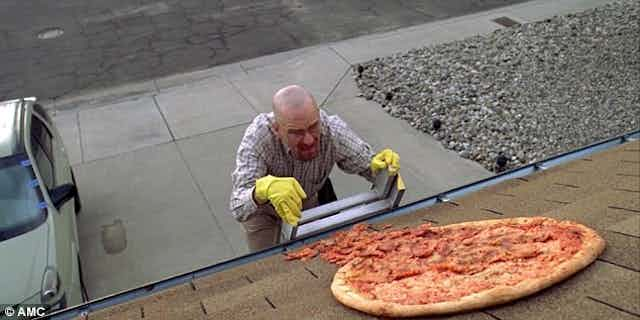It’s a delicious story: so many fans of the US crime series Breaking Bad have tried to recreate the scene where protagonist Walter White angrily throws a pizza on to the roof of his house that the real world owners have built a six-foot fence around the property to keep them out.
Imitation may be the sincerest form of flattery, but it’s easy to understand why the real life residents are not so impressed. While there is clearly an attraction for fans to travel to get close to their favourite film or TV series, sometimes this devotion can cause problems for the people who have to put up with all the attention.
For fans, these trips are important – it reinforces their love of, and loyalty to, their favourite TV shows. It illustrates how big a fan they are and it makes the fiction appear more real. As you would imagine, many tourist destinations are also keen to profit from any links they have to popular culture – offering official tours and merchandise to attract travelling fans. For example, visiting Graceland has become a mini industry in itself – for an Elvis fan, no trip to Memphis is complete without going there.
It was recently reported that traffic is to be banned from part of a road in County Antrim in Northern Ireland, made famous by the TV fantasy drama Game of Thrones, to protect its famous tunnel of beech trees known as the Dark Hedges. You can understand the local people’s wish to preserve the natural beauty of the road – but it’s hard to deny the attraction of the revenue that Game of Thrones has brought to the region – an estimated £150m.
Similarly, for a city such as Albuquerque, New Mexico (not renowned for its global tourist attractions), the increase in tourism related to both AMC’s Breaking Bad and the current Better Call Saul is important for local businesses and residents. Nevertheless, some fans have become a nuisance, as in the case of the pizza throwing pests – so regulating private and public access to the former filming location has become a hot topic for locals.
For the majority of fans, many of whom pay to go as part of an official tour group which actually cooperates with the home owners so as not to disturb their daily routine, simply taking a picture of themselves in front of the location is an important part of their fandom. So when fans pass through spaces made famous in the media, taking photos to preserve the moment is a celebration of their relationship with the TV show or movie. Building a fence will not only prevent fan photography but it may disrupt the congenial relationship between local business, tourists and residents which has been carefully built up over years.
When I visited the house as part of my own research on fan tourism earlier this year, I was impressed by the relationship our tour guide had with the family, how warmly they welcomed the tour group and how interested they seemed in what brought us there to visit.

Pilgrim’s progress
In my own research, I see clear parallels between the centuries-old religious pilgrimage to sacred sites of worship and the pilgrimages that fans make to locations of popular culture they cherish. Taking pictures of buildings, landscapes and people at these popular media sites becomes a way of affirming their affection for the show. But it is also about achieving some sort of mastery or control. Being there, comparing photos with the images on screen, seeing how shots were filmed in relation to what is really there gives fans a better understanding of the filming process.
This knowledge taps into a fan preoccupation for learning and developing their expertise. It also offers fans another more personal connection to the series; when watching and rewatching it, they can imagine themselves being there – they are now part of it. In terms of being a fan, memories of the tourist site captured in photos and video strengthen the connection to popular media and enhance the fan experience.
For example, a short film made by fans of the original Ghostbusters (see below) works as a travel guide for other fans who might want to visit New York City filming locations, but it also highlights the real affection these fans have for the movie.
Fan tourism is about the relationship between space, place, memory and fan identity. Those fans who travel to sites made special through their appearance on screen get something out of visiting. It makes the fictional text more real and renders the viewing experience more special when they return to it. What negative news coverage of fan tourism neglects to share is that the vast majority of fans work with local businesses and residents to get access to special sites – and they value them just as much as the locals.
Surely rather than building fences or banning cars, it would be better for all concerned to work out ways in which these special sites are managed? Most fans are happy to pay for their homage to the film or series that they love, so why not make it a win-win situation for all.

